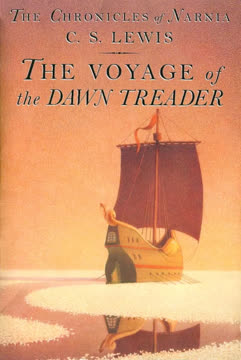Plot Summary
A Mysterious Wardrobe Discovery
On a rainy day, Lucy Pevensie explores the Professor's house and discovers a wardrobe that leads to Narnia, a snowy, magical land. Her curiosity leads her deeper into this world, marking the boundary between the familiar and the fantastical.
Lucy Meets a Faun
Lucy meets Mr. Tumnus, a faun who initially plans to betray her to the White Witch but changes his mind due to Lucy's kindness. He warns her of the dangers in Narnia and helps her return to the wardrobe.
Edmund's Deceptive Encounter
Edmund follows Lucy into Narnia and meets the White Witch, who seduces him with enchanted Turkish Delight and promises of power. This encounter sets the stage for conflict as Edmund becomes torn between loyalty to his family and the Witch's temptations.
The Siblings' Disbelief
Back in the real world, Lucy's siblings dismiss her story about Narnia. Edmund, having also visited Narnia, denies its existence, deepening the rift between them and creating tension.
The Beavers' Secret Plan
The Pevensie siblings meet Mr. and Mrs. Beaver, who reveal the prophecy of Aslan's return and the end of the White Witch's reign. This alliance marks the beginning of their quest to save Narnia.
The Witch's Icy Grasp
Edmund informs the Witch of his siblings' presence in Narnia. The Witch plans to capture them, while the Beavers and the remaining siblings prepare to flee, understanding the urgency of reaching Aslan.
Edmund's Betrayal and Regret
Under the Witch's influence, Edmund betrays his siblings but begins to regret his decisions after witnessing her cruelty. His internal conflict sets the stage for his eventual redemption.
The Witch's Icy Pursuit
The White Witch pursues the Pevensies with Edmund in tow. As the snow melts, signaling Aslan's return, the Witch's desperation grows, and she becomes more ruthless.
Spring's Arrival and Hope
As the Pevensies journey towards Aslan, the landscape transforms from winter to spring, symbolizing hope and the weakening of the Witch's power.
Aslan's Majestic Presence
The Pevensies meet Aslan, whose presence is both terrifying and comforting. Aslan's wisdom and strength reassure them, preparing them for the battle against the Witch.
The Battle for Narnia
The Pevensies, alongside Aslan, engage in a fierce battle against the Witch's forces. Aslan's intervention leads to the Witch's defeat and the restoration of peace in Narnia.
Eustace's Unwanted Adventure Begins
Eustace Clarence Scrubb, skeptical of Narnia, is pulled into the world through a magical painting. He struggles to adapt to the ship's life and the reality of Narnia.
The Dragon's Lair Discovery
Eustace discovers a dragon's cave filled with treasure and, driven by greed, falls asleep on the hoard, transforming into a dragon himself.
Transformation and Realization
As a dragon, Eustace experiences isolation and fear, leading to a desire for redemption and reconciliation with his companions.
Caspian's Diplomatic Challenge
Caspian discovers slavery on the Lone Islands and takes action, liberating the islands and restoring justice and order.
A Mysterious Underground Journey
The trio is led deeper into the Underland by the Earthmen, eventually reaching a massive underground lake and a mysterious Queen.
The Queen's Sinister Intentions
The Queen of the Underland reveals her intention to use the travelers in her scheme to conquer the Overland, prompting them to escape.
The True Narnia Unveiled
Emerging from the Underland, the travelers find a more vibrant Narnia, symbolizing the eternal Narnia beyond the shadowlands, and are welcomed into a new chapter of their lives.
Characters
Lucy Pevensie
Lucy is the youngest Pevensie sibling, whose discovery of Narnia sets the adventure in motion. Her innocence and kindness are pivotal, driving the narrative and embodying hope and courage.
Edmund Pevensie
Edmund's susceptibility to the Witch's manipulation leads to betrayal, but his eventual redemption highlights themes of temptation and forgiveness.
Mr. Tumnus
Initially planning to betray Lucy, Mr. Tumnus's conscience prevails, setting the stage for the Pevensies' involvement in Narnia's fate.
The White Witch (Jadis)
The Witch enforces eternal winter and rules with fear, embodying the oppressive force the Pevensies must overcome.
Peter Pevensie
As the eldest sibling, Peter's leadership and bravery are crucial in the fight against the Witch, emphasizing themes of responsibility.
Susan Pevensie
Susan's skepticism gives way to belief, supporting her siblings in their quest and highlighting the importance of family unity.
Eustace Clarence Scrubb
Eustace's transformation into a dragon forces him to confront his flaws, leading to a profound change in character and newfound humility.
King Caspian
Caspian's leadership is marked by justice and diplomacy, as he navigates challenges and restores order, embodying the ideals of a true king.
Puddleglum
Puddleglum's wisdom and courage are crucial in the group's efforts to rescue Prince Rilian, keeping them grounded and inspired.
Prince Rilian
Enchanted by the Queen, Rilian's rescue is key to the travelers' success, highlighting themes of redemption and love.
Plot Devices
The Wardrobe
The wardrobe symbolizes the boundary between the mundane and the fantastical, initiating the adventure and challenging perceptions of reality.
Turkish Delight
The enchanted Turkish Delight represents the allure of power and manipulation, catalyzing Edmund's betrayal and highlighting moral challenges.
Aslan
Aslan symbolizes justice and the end of tyranny, inspiring courage and unity, and emphasizing themes of sacrifice and redemption.
The Melting Snow
The transition from winter to spring signifies the weakening of the Witch's power and the return of Aslan's influence, reflecting themes of renewal.
Aslan's Sacrifice
Aslan's sacrifice for Edmund underscores themes of forgiveness and selflessness, pivotal in redeeming Edmund and inspiring the Pevensies.
The Prophecy
The prophecy of the Pevensies' rise and the Witch's defeat drives the story, providing destiny and purpose in Narnia's liberation.
The Dragon's Curse
The curse forces Eustace to confront his flaws, highlighting themes of redemption and personal growth through Aslan's intervention.
Aslan's Signs
Aslan's signs guide the travelers, emphasizing faith, memory, and perseverance in overcoming challenges and breaking enchantments.
The True Narnia
The discovery of the true Narnia symbolizes the eternal nature of Aslan's kingdom, offering hope and a better world beyond the shadowlands.
Analysis
"The Chronicles of Narnia" by C.S. Lewis is a rich tapestry of adventure, morality, and fantasy, exploring themes of redemption, courage, and the battle between good and evil. Through the Pevensie siblings' journey, Lewis delves into the complexities of human nature, the allure of power, and the transformative power of forgiveness and love. The narrative structure, with its vivid characters and symbolic plot devices, invites readers to reflect on the importance of faith, unity, and the pursuit of justice. The story's enduring appeal lies in its ability to transport readers to a world where the triumph of good over evil is not only possible but inevitable, offering a hopeful vision of a better world.
Last updated:
FAQ
Synopsis & Basic Details
What is The Chronicles of Narnia about?
- A Journey Through Worlds: The Chronicles of Narnia tells the story of children who discover the magical world of Narnia, a land filled with talking animals, mythical creatures, and epic battles between good and evil.
- Battles of Good vs. Evil: The series explores the ongoing conflict between the forces of light, led by the majestic lion Aslan, and the forces of darkness, often embodied by tyrannical figures and witches.
- Growth and Transformation: The children, through their adventures in Narnia, undergo significant personal growth, learning about courage, sacrifice, and the importance of faith and loyalty.
Why should I read The Chronicles of Narnia?
- Immersive Fantasy World: The series offers a richly detailed and imaginative world that captivates readers of all ages, with its unique blend of mythology, folklore, and Christian allegory.
- Exploration of Timeless Themes: The books delve into profound themes such as good versus evil, redemption, sacrifice, and the nature of faith, providing valuable insights into the human condition.
- Engaging Characters and Adventures: Readers will be drawn to the memorable characters and their thrilling adventures, which are filled with magic, battles, and emotional depth.
What is the background of The Chronicles of Narnia?
- Allegorical Christian Themes: The series is heavily influenced by Christian theology, with Aslan representing Christ, and the stories often reflecting themes of sacrifice, redemption, and the battle between good and evil.
- World War II Context: The books were written during and after World War II, and the themes of displacement, loss, and the struggle against tyranny reflect the anxieties and hopes of that era.
- Literary and Mythological Influences: C.S. Lewis drew inspiration from various literary and mythological sources, including Greek and Roman mythology, medieval literature, and fairy tales, creating a unique and layered world.
What are the most memorable quotes in The Chronicles of Narnia?
- "Wrong will be right, when Aslan comes in sight.": This quote from The Magician's Nephew encapsulates the hope and promise of Aslan's return, a recurring theme throughout the series.
- "Once a king or queen in Narnia, always a king or queen.": This quote from The Lion, the Witch, and the Wardrobe emphasizes the lasting impact of Narnia on those who have ruled there, highlighting the eternal nature of their experiences.
- "To the last, I oppose you.": This quote from The Last Battle demonstrates the unwavering courage and loyalty of the Narnians, even in the face of ultimate defeat, showcasing the power of conviction.
What writing style, narrative choices, and literary techniques does C.S. Lewis use?
- Allegorical Storytelling: Lewis employs allegory to convey deeper moral and spiritual truths, with characters and events often representing abstract concepts or figures from Christian theology.
- Direct and Accessible Prose: The writing style is clear and straightforward, making the complex themes accessible to younger readers while still engaging adults with its depth and nuance.
- Use of Foreshadowing and Symbolism: Lewis masterfully uses foreshadowing and symbolism to create a sense of anticipation and to enrich the narrative, with recurring motifs like the wardrobe, the lamp-post, and the Stone Table adding layers of meaning.
Hidden Details & Subtle Connections
What are some minor details that add significant meaning?
- The Significance of Names: The names of characters, such as Aslan (meaning "lion" in Turkish) and Tash (a reference to a pagan deity), often carry symbolic weight, hinting at their true nature and roles in the narrative.
- Recurring Motifs: The recurring motifs of light and darkness, winter and spring, and the sea and mountains, subtly reinforce the thematic conflicts and the cyclical nature of good and evil in Narnia.
- The Importance of Small Acts: Seemingly minor acts of kindness, such as Mr. Tumnus's decision to help Lucy, or the mice gnawing through Aslan's ropes, highlight the significance of individual choices and their impact on the larger story.
What are some subtle foreshadowing and callbacks?
- The Deplorable Word: The mention of the Deplorable Word in The Magician's Nephew foreshadows the destructive power of evil and the consequences of unchecked ambition, echoing the themes of later books.
- The Green Rings: The green rings in The Magician's Nephew are later revealed to be the means of returning from other worlds, foreshadowing the children's journeys back to their own world.
- The Prophecy: The various prophecies throughout the series, such as the one about the four thrones at Cair Paravel, create a sense of destiny and interconnectedness, linking different stories and characters.
What are some unexpected character connections?
- The Shared Traits of Villains: The similarities between Uncle Andrew and the White Witch, particularly their shared belief in their own superiority and their disregard for common rules, highlight the nature of evil and its various manifestations.
- The Parallel Journeys of Digory and Eustace: Both Digory and Eustace undergo transformative experiences in Narnia, learning humility and empathy through their encounters with magic and other worlds.
- The Connection Between the Cabby and the First King: The Cabby's transformation into King Frank and his wife's transformation into Queen Helen, reveal the potential for ordinary people to become extraordinary leaders in Narnia.
Who are the most significant supporting characters?
- The Beavers: Mr. and Mrs. Beaver provide crucial guidance and support to the Pevensies, embodying the values of loyalty, hospitality, and practical wisdom.
- Doctor Cornelius: As Caspian's tutor, Doctor Cornelius imparts knowledge of Old Narnia and its history, playing a key role in shaping Caspian's understanding of his heritage and destiny.
- Reepicheep: The valiant mouse embodies courage, honor, and a deep longing for Aslan's country, inspiring others with his unwavering faith and determination.
Psychological, Emotional, & Relational Analysis
What are some unspoken motivations of the characters?
- Edmund's Desire for Recognition: Edmund's initial betrayal stems from a desire for power and recognition, fueled by his feelings of being overlooked and undervalued within his family.
- The White Witch's Fear of Aslan: The White Witch's actions are driven by a deep-seated fear of Aslan and his power, which she attempts to counteract through control and destruction.
- Uncle Andrew's Craving for Power: Uncle Andrew's fascination with magic is rooted in a desire for power and control, which he seeks to achieve through manipulation and exploitation of others.
What psychological complexities do the characters exhibit?
- Digory's Burden of Responsibility: Digory's journey in The Magician's Nephew is marked by his struggle with guilt and responsibility for his actions, highlighting the psychological toll of making difficult choices.
- Eustace's Internal Conflict: Eustace's transformation into a dragon and his subsequent journey reveal his internal struggle with selfishness and his gradual development of empathy and selflessness.
- Susan's Struggle with Faith: Susan's eventual rejection of Narnia reflects her struggle with faith and her desire for a more rational and predictable world, highlighting the challenges of maintaining belief in the face of doubt.
What are the major emotional turning points?
- Lucy's Discovery of Narnia: Lucy's initial encounter with Narnia and her subsequent struggle to convince her siblings mark a turning point in her emotional journey, highlighting her unwavering faith and courage.
- Edmund's Redemption: Edmund's remorse and eventual sacrifice for his siblings represent a major emotional turning point, showcasing the power of forgiveness and the possibility of redemption.
- Caspian's Encounter with Aslan: Caspian's meeting with Aslan and his subsequent acceptance of his role as King mark a significant emotional turning point, highlighting his growth and acceptance of his destiny.
How do relationship dynamics evolve?
- The Pevensie Siblings' Bond: The Pevensie siblings' relationships evolve throughout the series, with their initial conflicts giving way to a deep bond of loyalty, love, and mutual respect.
- The Complex Relationship Between Caspian and Aslan: Caspian's relationship with Aslan is marked by both reverence and a desire for understanding, highlighting the complexities of faith and the search for meaning.
- The Unlikely Friendship Between Eustace and Reepicheep: The unlikely friendship between Eustace and Reepicheep demonstrates the transformative power of shared experiences and the ability to find common ground despite differences.
Interpretation & Debate
Which parts of the story remain ambiguous or open-ended?
- The Nature of Aslan's Country: The exact nature of Aslan's country and its relationship to the other worlds remains ambiguous, inviting readers to contemplate the nature of the afterlife and the ultimate destination of the faithful.
- The Fate of Susan: Susan's rejection of Narnia and her focus on worldly concerns leave her fate open-ended, prompting debate about the nature of faith and the consequences of abandoning one's beliefs.
- The True Identity of Tash: The true nature of Tash and its relationship to Aslan remains ambiguous, raising questions about the nature of evil and the possibility of misinterpreting divine will.
What are some debatable, controversial scenes or moments in The Chronicles of Narnia?
- The Treatment of Susan: Susan's exclusion from Aslan's country has sparked debate about the role of women in the series and the consequences of prioritizing worldly concerns over faith.
- The Depiction of Calormenes: The portrayal of Calormenes as a monolithic, dark-skinned, and often cruel culture has been criticized for perpetuating stereotypes and raising questions about cultural representation.
- The Nature of Aslan's Justice: Aslan's actions, particularly his acceptance of sacrifice and his sometimes harsh judgments, have led to discussions about the nature of divine justice and the complexities of morality.
The Chronicles of Narnia Ending Explained: How It Ends & What It Means
- The End of Narnia: The series concludes with the destruction of Narnia and the transition to a new, more perfect world, symbolizing the end of earthly existence and the promise of eternal life.
- The Reunion in Aslan's Country: The reunion of the Pevensies and other beloved characters in Aslan's country signifies the ultimate reward for faith and loyalty, offering a vision of eternal joy and fulfillment.
- The Importance of the Journey: The ending emphasizes that the journey through Narnia, with all its challenges and triumphs, was ultimately a preparation for a greater reality, highlighting the transformative power of faith and experience.
Review Summary
The Chronicles of Narnia is a beloved fantasy series that has captivated readers for generations. Many praise its imaginative world-building, memorable characters, and Christian allegory. Some readers appreciate the books' moral lessons and spiritual themes, while others find them heavy-handed or outdated. The series' enduring popularity is attributed to its ability to engage both children and adults, though some criticize its portrayal of certain cultures and gender roles. Overall, the books remain influential and nostalgic for many, despite mixed opinions on their religious content and social implications.
The Chronicles of Narnia (Chronological Order) Series
Similar Books










Download PDF
Download EPUB
.epub digital book format is ideal for reading ebooks on phones, tablets, and e-readers.













